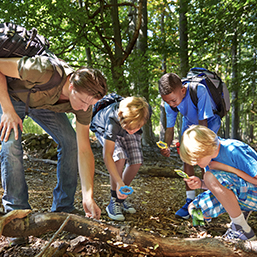
Getting kids off their devices and sending them outdoors is something we hear a lot about these days. Experts have been telling us for years that outdoor play is essential for healthy child development. In 2015, the Council of Chief Medical Officers of Health in Canada released this statement: "Access to active play in nature and outdoors – with its risks – is essential for healthy child development. We recommend increasing children's opportunities for self-directed play outdoors in all settings – at home, at school, in child care, the community and nature." In 2020, the COVID-19 pandemic really brought to the forefront the physical and psychological benefits of being outdoors.
\n \nAt this time, we saw a big spike in the number of forest schools and outdoor learning programs for kids, with Outdoor Play Canada reporting 34 just in Alberta, which doesn’t even include nature-focused dayhomes. In addition to this number, several elementary schools are also developing a niche in offering outdoor learning, such as Percy Pegler in Okotoks. An increasing number of teachers are also taking the initiative to get their students outdoors and connecting to nature. Take Me Outside, a non-profit focused on promoting outdoor learning, has numerous outdoor learning challenges for schools, professional development opportunities, and resources for teachers, as well as a mentorship program for teachers. They even have an outdoor learning certification program for teachers!
\nPeople often ask, what is forest school and how is it different from outdoor learning? While both of these approaches all focus on getting kids outside and connection to nature, there are differences in their philosophies. According to the Child and Nature Alliance of Canada, “Forest schools are an educational ethos and practice that centres the Land and the child-at-play. Children and educators build a relationship with the Land through regular and repeated access to the same outdoor space over an extended period of time. Educators support learning through a pedagogical framework that is rooted in place and play, directed and inspired by the child (emergent curriculum), and driven by a process of inquiry.” Outdoor learning has multiple interpretations, but generally means a pedagogical approach to meeting curricular outcomes through outdoor activities and inquiries that connect kids to the natural world.
\nRegardless of the name or approach, these outdoor and nature-focused programs have infinite benefits for our children, and can be a perfect complement to traditional learning settings. Here are some of the highlights of how outdoor learning opportunities support kids to thrive:
\nIt’s exciting to see new outdoor programs emerging, and traditional school settings starting to embrace all the wonderful ways outdoor learning can complement indoor learning. Educators and parents alike are seeing the benefits firsthand of how nature’s classroom can support our children to grow, learn, and thrive!
\n\n
Devon is a pediatric physiotherapist with 15 years experience in a variety of settings. She is a relentless advocate for a child’s right to play, and runs a business called Nature Play, which provides nature-based play and therapeutic groups for children of all ages.
\n
See our related articles:
Calgary’s Child Magazine © 2025 Calgary’s Child